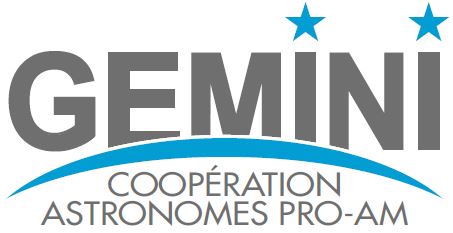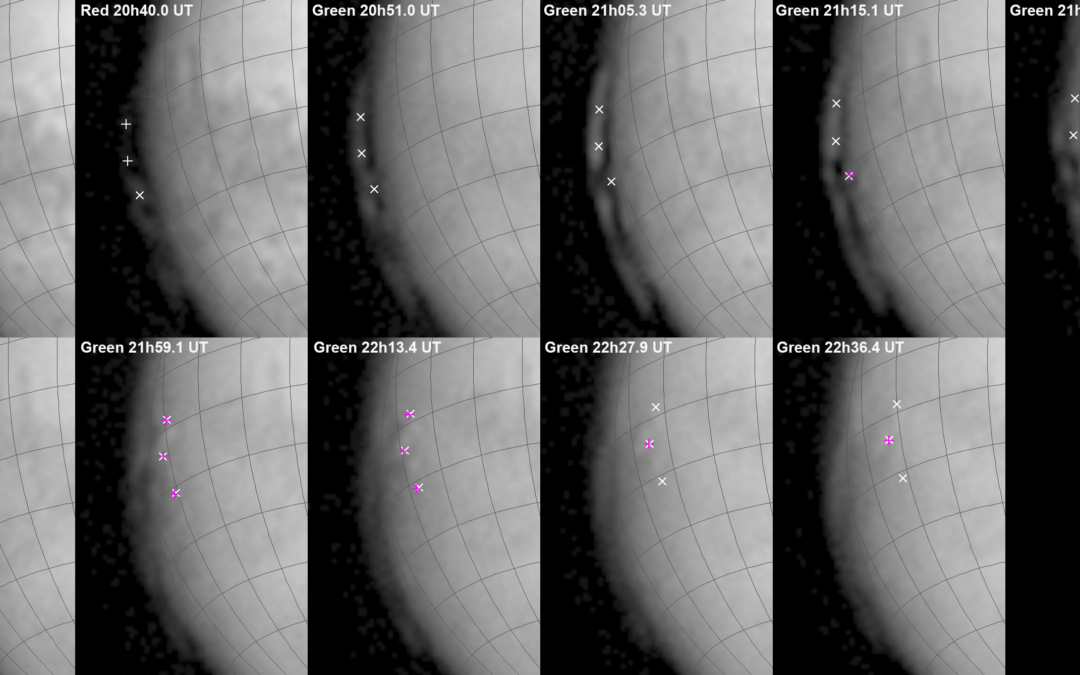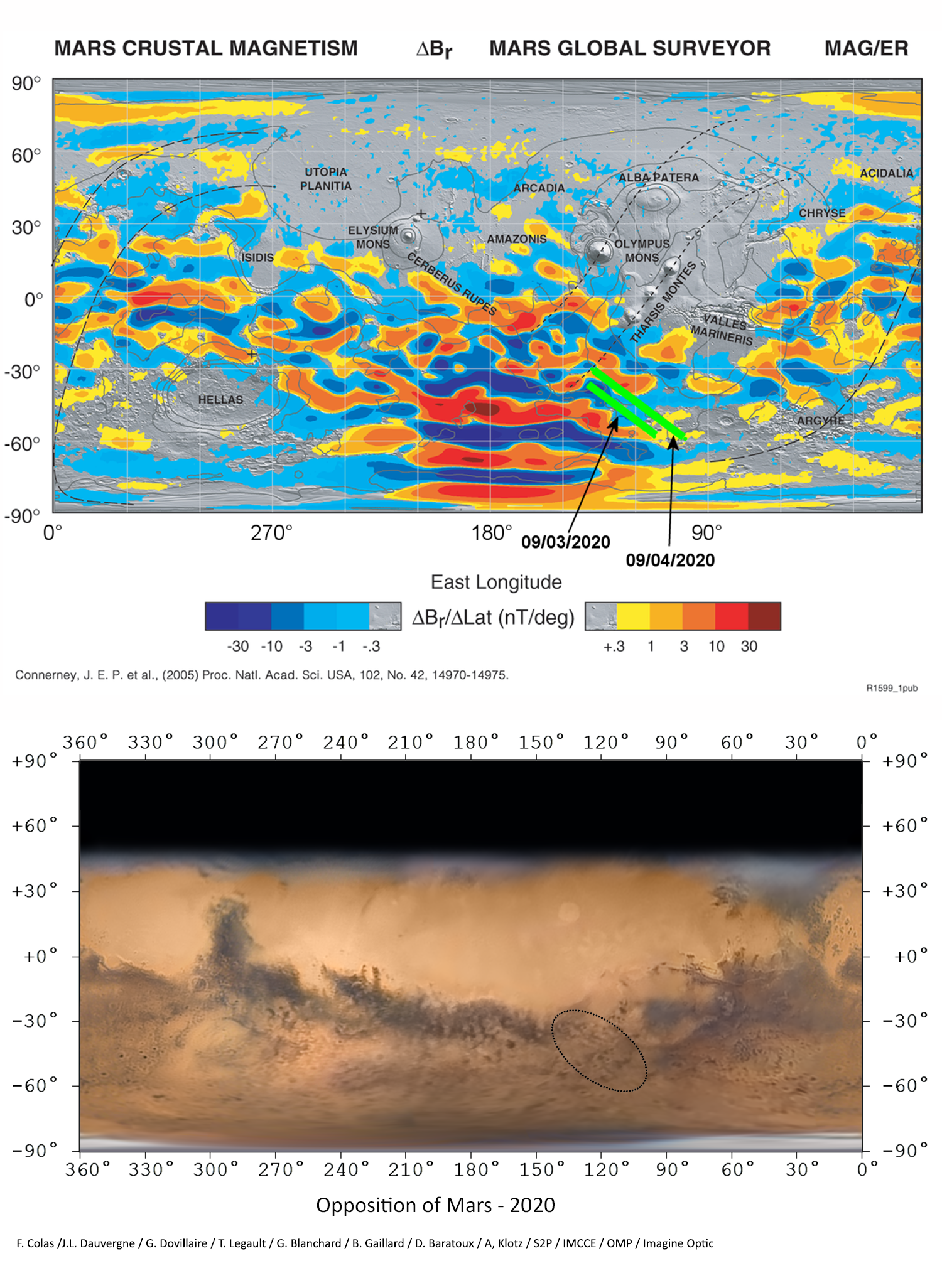En 2005, la mission spatiale Mars Express a découvert des aurores dans l’ionosphère de Mars. Cependant, elles ont été mesurées dans le domaine UV et, de ce fait, tous les scientifiques ne les ont pas qualifiées d’aurores, ces dernières étant généralement visibles à l’œil nu. J’étais dans l’équipe en charge de la modélisation, ce qui nous a permis de caractériser les caractéristiques du vent solaire à l’origine de ces émissions. Dix ans plus tard, grâce à des expériences en laboratoire et à de nouvelles modélisations, j’ai pu prédire que ces mêmes émissions UV avaient leurs équivalents dans le domaine visible : bleu (412 nm et 434 nm) et vert (557,7 nm) à 140 km de hauteur, rouge (630 nm) à 160 km.
Un nouvel article a été publié, suscitant beaucoup d’enthousiasme, surtout car dans certaines occasions, ces aurores devraient être suffisamment intenses pour être visibles à l’œil nu. La course a alors commencé pour les photographier. Aucune expérience spatiale n’est en réalité pleinement capable d’une telle performance. Nous avons donc eu l’idée de profiter des oppositions régulières de Mars (environ tous les 2 ans) pour les observer depuis la Terre, avec l’aide des astrophotographes. En 2020, nous avons eu une détection positive. Cependant, une analyse approfondie – en particulier photométrique – a prouvé qu’il ne s’agissait pas d’aurores, mais de nuages de haute altitude (92 km de hauteur). Un modèle de transfert radiatif a montré qu’ils sont probablement dus à des cristaux de glace de CO2, bien que la glace d’eau ne puisse être totalement exclue pour l’instant. Cet article a de nouveau suscité beaucoup d’intérêt dans différentes communautés, et a remporté le prix Gemini (SAF/SF2A) de collaboration astronomes pro-am en 2023. En 2022, nous n’avons pas eu de chance avec la météo et n’avons pas pu faire d’observations intéressantes. La prochaine opportunité sera fin 2024/début 2025. Notre groupe a décidé d’agrandir considérablement le pool d’observateurs afin de couvrir toutes les latitudes, tous les continents, pour assurer une observation positive avec un double objectif : caractériser ces nuages étonnants et voir, pour la première fois, les aurores, profitant du maximum solaire du cycle 25. Cela est particulièrement intéressant, car une première détection indirecte semble avoir eu lieu en mai avec un instrument spatial sur Mars.
Appel à observations
Cet appel vise à participer à une campagne internationale pour découvrir les aurores bleues de Mars et caractériser les nuages en haute altitude sur Mars.
Zones de magnétisme résiduel de la surface martienne
Protocole d’observation
Il s’agit d’observer Mars dans plusieurs gammes photométriques (bleue, verte, rouge, RGB). Le diamètre minimum recommandé est de 200 à 250mm pour avoir suffisamment de résolution et de lumière sur les phénomènes recherchés. Une caméra couleur est utilisable mais une monochrome est conseillée si on veut faire des images dans différentes longueurs d’onde. Dans ce cas, une roue à filtre est un plus évident pour séparer les longueurs d’onde.
Il faut prendre des images planétaires classiques de Mars, en priorité en lumière bleue (filtre bleu large) pour la détection de nuages de haute altitude ou d’aurores, mais une analyse photométrique (roue à filtre) est un plus important. Il faudrait faire plusieurs images de manière à pouvoir suivre l’évolution et la rotation (avec la planète) potentielles d’une formation suspecte détectée.
Inscription
Participer à ces observations vous intéresse ?
Signalez-vous aux contacts définis ci-après.
Envoyez vos observations de formation suspecte aux contacts ci-dessous (à minima à Jean et Jean-Luc).
Spécifiquement pour les aurores
- En plus un filtre étroit spécifique autour de 425nm est conseillé. Il est disponible ici : https://www.edmundoptics.fr/p/425nm-cwl-25mm-dia-hard-coated-od-4-50nm-bandpass-filter/29361/, Il faudra trouver un moyen de l’adapter aux coulants utilisés en astronomie. Il faudra faire des séquences avec un filtre bleu large et le filtre bleu étroit.
- On suspecte que les aurores seront observées autour des zones de magnétisme résiduel de la surface martienne, la principale étant autour de –30° de latitude et 170° de longitude, donc avec cette zone (qui est assez large, voir carte ci-dessus) proche du limbe, ou du méridien.
- Comme pour les aurores terrestres, elles pourront être plus visibles dans une période de forte activité solaire dirigée vers la planète.
Contacts
Professionnel :
Jean Lilensten – Univ. Grenoble-Alpes, CNRS, IPAG, jean.lilensten[at]univ-grenoble-alpes.fr
Amateurs :
Jean-Luc Dauvergne – Société de Planétologie des Pyrénées (S2P), jl.dauvergne[at]cieletespace.fr
Christophe Pellier – commission des observations planétaires de la SAF, chrispellier[at]sfr.fr
Marc Delcroix – commission des observations planétaires de la SAF, delcroix.marc[at]free.fr
Emmanuel Beaudoin – Univ. Paris-Saclay, LPS, emmanuel.beaudoin[at]universite-paris-saclay.fr
Detection of auroras and high altitude clouds on Mars
In 2005, the Mars Express space mission discovered auroras in the ionosphere of Mars. However, they were measured in the UV range and, as a result, not all scientists have described them as auroras, which are usually visible to the naked eye. I was in the team in charge of modelling, which allowed us to characterise the characteristics of the solar wind at the origin of these emissions. Ten years later, thanks to laboratory experiments and new modelling, I was able to predict that these same UV emissions had their equivalents in the visible range: blue (412 nm and 434 nm) and green (557.7 nm) at 140 km height, red (630 nm) at 160 km.
A new article has been published, causing a lot of excitement, especially since on some occasions these auroras should be intense enough to be visible to the naked eye. The race then began to photograph them. In reality, no space experiment is fully capable of such a performance. So we had the idea of taking advantage of the regular oppositions of Mars (about every 2 years) to observe them from Earth, with the help of astrophotographers. In 2020, we had a positive detection. However, an in-depth analysis – especially photometric analysis – proved that these were not auroras, but high-altitude clouds (92 km high).
A radiative transfer model has shown that they are probably due to CO2 ice crystals, although water ice cannot be completely ruled out for now. This paper again generated a lot of interest in different communities, and won the Gemini (SAF/SF2A) prize for pro-am astronomer collaboration in 2023. In 2022, we were unlucky with the weather and were not able to make any interesting observations. The next opportunity will be late 2024/early 2025. Our group has decided to considerably expand the pool of observers in order to cover all latitudes, all continents, to ensure a positive observation with a double objective: to characterize these amazing clouds and to see, for the first time, the auroras, taking advantage of the solar maximum of cycle 25. This is particularly interesting, as a first indirect detection appears to have taken place in May with a space instrument on Mars.
Call to observations
This call aims to participate in an international campaign to discover the blue auroras of Mars and characterize the clouds at high altitude on Mars.
Zones of residual magnetism of the Martian surface
Observation Protocol
It involves observing Mars in several photometric ranges (blue, green, red, RGB). The recommended minimum diameter is 200 to 250mm to have enough resolution and light on the desired phenomena. A color camera can be used but a monochrome is recommended if you want to make images in different wavelengths. In this case, a filter wheel is an obvious plus for separating wavelengths.
Conventional planetary images of Mars must be taken, primarily in blue light (wide blue filter) for the detection of high-altitude clouds or auroras, but a photometric analysis (filter wheel) is an important plus. Several images would have to be taken in order to be able to follow the potential evolution and rotation (with the planet) of a detected suspicious formation.
Registration
Interested in participating in these observations?
Report yourself to the contacts defined below.
Send your observations of suspicious formation to the contacts below (at least to Jean and Jean-Luc).
Specifically for the Aurora
- In addition, a specific narrow filter around 425nm is recommended. It is available here: https://www.edmundoptics.fr/p/425nm-cwl-25mm-dia-hard-coated-od-4-50nm-bandpass-filter/29361/, We will have to find a way to adapt it to the flows used in astronomy. You will have to make sequences with a wide blue filter and the narrow blue filter.
- It is suspected that the auroras will be observed around the areas of residual magnetism of the Martian surface, the main one being around –30° latitude and 170° longitude, so with this area (which is quite large, see map above) close to the limb, or meridian.
- As with the Earth’s auroras, they may be more visible during a period of strong solar activity directed towards the planet.
Contacts
Professionnal :
Jean Lilensten – Univ. Grenoble-Alpes, CNRS, IPAG, jean.lilensten[at]univ-grenoble-alpes.fr
Amateurs :
Jean-Luc Dauvergne – Société de Planétologie des Pyrénées (S2P), jl.dauvergne[at]cieletespace.fr
Christophe Pellier – commission des observations planétaires de la SAF, chrispellier[at]sfr.fr
Marc Delcroix – commission des observations planétaires de la SAF, delcroix.marc[at]free.fr
Emmanuel Beaudoin – Univ. Paris-Saclay, LPS, emmanuel.beaudoin[at]universite-paris-saclay.fr



Commentaires récents